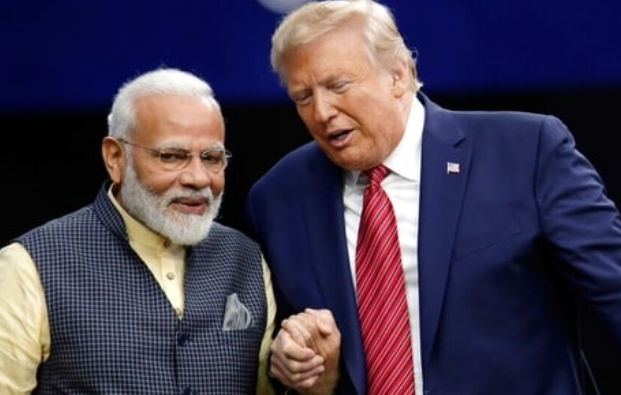
In a major geopolitical and economic jolt, U.S. President Donald Trump has officially signed an executive order imposing an additional 25% tariff on Indian imports, bringing the total tariff burden on Indian goods entering the U.S. to a steep 50%. This move comes within the 24-hour deadline Trump had himself hinted at in a previous address, where he warned of consequences if India continued oil trade with Russia.
The White House confirmed the development, stating that the President has signed the order as a punitive measure for India’s ongoing energy imports from Russia, despite repeated warnings and diplomatic efforts from the U.S. Trump has accused India of profiting from the war in Ukraine by purchasing Russian crude, refining it, and selling it in international markets for profit. The administration views this as aiding Russia indirectly in a time of global conflict.
According to official sources, the new tariffs will come into effect from August 27, giving a short window for any possible reversal or negotiations. However, given Trump's past pattern of sudden and rigid trade decisions, expectations for a rollback remain low.
The hike essentially means that Indian goods which earlier attracted a 25% tariff in the U.S. will now attract 50%. For example, if a product worth $100 used to cost $125 to an American buyer, now it will cost $150, making Indian exports significantly less competitive in the American market.
Impact on India’s Trade and Economy
This sudden tariff escalation poses serious challenges to Indian exporters. The U.S. remains one of India’s biggest trading partners, especially in sectors such as textiles, pharmaceuticals, IT services, and auto components. A higher tariff directly reduces the competitiveness of Indian goods, threatening India’s trade surplus with the U.S., which has been one of the few bright spots in the country's export performance.
The rising costs due to higher tariffs could lead to lower demand from American buyers, hitting Indian exporters’ revenues and margins. A reduction in exports could also have a negative impact on India's GDP, especially at a time when global trade is already under stress due to multiple geopolitical tensions.
One of the major concerns is that India's net exports, which already contribute negatively to GDP due to a persistent trade deficit, may worsen further if the trade surplus with the U.S. vanishes.
Stock Market Reaction: Initial Jitters Visible
The market reaction to the news was swift. Gift Nifty dropped nearly 80 points, immediately after the announcement of the executive order, reflecting market sentiment turning sour. Since the order came late in the day, the full impact will likely be visible in the domestic equity market on the following trading day.
U.S.-listed Indian ADRs (American Depository Receipts) also showed a mixed reaction. Infosys ADR dropped by about half a percent, Wipro saw a steeper decline, while ICICI Bank managed to stay in the green. HDFC Bank’s ADR, however, was trading in the red. Pharma majors like Dr. Reddy's were hit hard, partly due to uncertainty over the broader implications of U.S.-India trade tensions.
The Indian rupee also weakened, adding to the concerns of importers and foreign investors alike.
Sectoral Impact
Pharmaceuticals: Already under regulatory and pricing pressure in the U.S., the Indian pharma sector now faces even more uncertainty with additional tariffs. Companies like Sun Pharma, Dr. Reddy’s, and Cipla could face tougher times in the export market.
IT and Services: While service exports like software may remain relatively unaffected due to their non-tariff nature, any escalated tensions could spill over into other areas like H-1B visa regulations, data sharing, and taxation.
Banking: Indian banks with little exposure to international trade may not be directly affected. However, broader market weakness and slowdown in corporate exports may indirectly impact lending growth and NPAs.
Is This the Final Blow?
Trump’s decision appears to be part of a broader pressure campaign against India’s energy ties with Russia. Despite several warnings and attempts to negotiate, India's steady purchase of discounted Russian crude oil has drawn sharp criticism from the U.S. administration. Trump’s rhetoric has accused India of profiting from war and disregarding Western sanctions and moral pressure.
While 50% tariff is already a huge blow, there is no guarantee that this is the end of punitive actions. Trump has previously used similar executive orders to escalate trade wars with China and the EU. His strategy appears aimed at using economic tools as leverage in geopolitical disputes.
The President had earlier alluded to additional penalties if India didn’t change its oil procurement behavior. Whether this 25% tariff qualifies as that penalty or something more is in the pipeline remains unclear. Analysts suggest that further trade or even financial sanctions could be explored by the Trump administration.
Conclusion
This decision significantly escalates trade tensions between India and the United States. It threatens not just near-term economic growth but also long-standing trade relations. While markets are absorbing the shock, uncertainty remains high, and much will depend on how the Indian government responds—whether through diplomacy, countermeasures, or seeking alternative trade alliances.
Investors, exporters, and policymakers will now closely watch any follow-up developments, including potential retaliatory tariffs from India or diplomatic engagements that could lead to a de-escalation.
Until then, market volatility is expected to continue, and the mood is clearly turning bearish, especially for export-dependent sectors. As geopolitical tensions seep deeper into trade and economic policy, businesses must brace for more disruption in the coming months.




